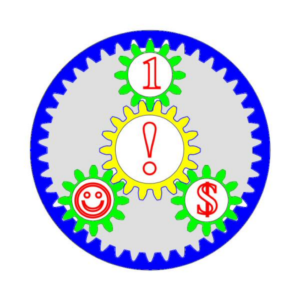The Future Is Now – Part 2
The future is now – part 2
In his previous blog post “The Future Is Now” Ryszard Chciuk presented the way his after-sales management team created the very important part of its strategy – vision. This week, in “The Future Is Now – Part 2” he will tell you what it was for.
The long-term goals work against each other, to a certain degree. Every head of every team is expected to clarify arising problems on a daily basis. Thus, the details from the reality are carving the final shape of our vision.
This vision was translated into a graphical representation, much easier to memorize. I changed the four long statements into four gears marked with symbols which are easily understood:
- 1 – we are recognized as the best,
- $ – we earn money,
- ☺ – everybody is happy,
- ! – we have no fears about the future.
Gears are to underline the interdependence of the four goals.
I communicated our long-term goals to all new workers of the after sales department. I illustrated it with many examples from the company life. It was usually taking place in the course of their first training led several weeks after starting the job. Later on, they could hear it again, and again, together with all employees of the dealership. It was part of my presentation during annual company meetings.
What was it for?
Imagine, you are a worker facing any serious problem, in the presence of the customer. You have to fix the problem right now, and you can’t get support from your superior. The future of our relations with the customer is in your hands. You force your brain to find optional solutions. The company expects you choose the best one. Don’t be afraid, you are equipped with a good tool, our vision. So, please check if the chosen solution brings us closer or moves us away from our long-term goals. Will the chosen solution satisfy our customer? Your decision will cost some money. You are aware that CFO and CEO are not happy when a field technician spends a penny without permission. So, will you take a risk or you will take a coffee break and wait until your superior lights up a green or a red light?
This kind of situation is not comfortable for any worker and his superiors. In my opinion it is better if the employee is not afraid to take a decision in such circumstances. Why? In general, company profit is generated on the front line, by salesmen and servicemen. They know better than CFO, CEO and any other supervisor, how to satisfy the customer with smaller money and how to fix customers’ equipment the most effective way. Finally, the front-line people create most of the company cost and they can save or waste a lot of company funds, if they want to. If you grant them trust and some authority, they become trustful and responsible. And vice versa.
***
Perhaps next time I wouldn’t go exactly that way, i.e., to establish a vision for only my department. The idea was good for my people, for customers and for the company. Unfortunately, it caused me a lot of stress. Every time the company faces market turbulence, heads of departments and the board are acting according to the visions known only by them, if they worked out any. Those separate visions are usually incompatible. As a result of that, we fight problems in chaos.


